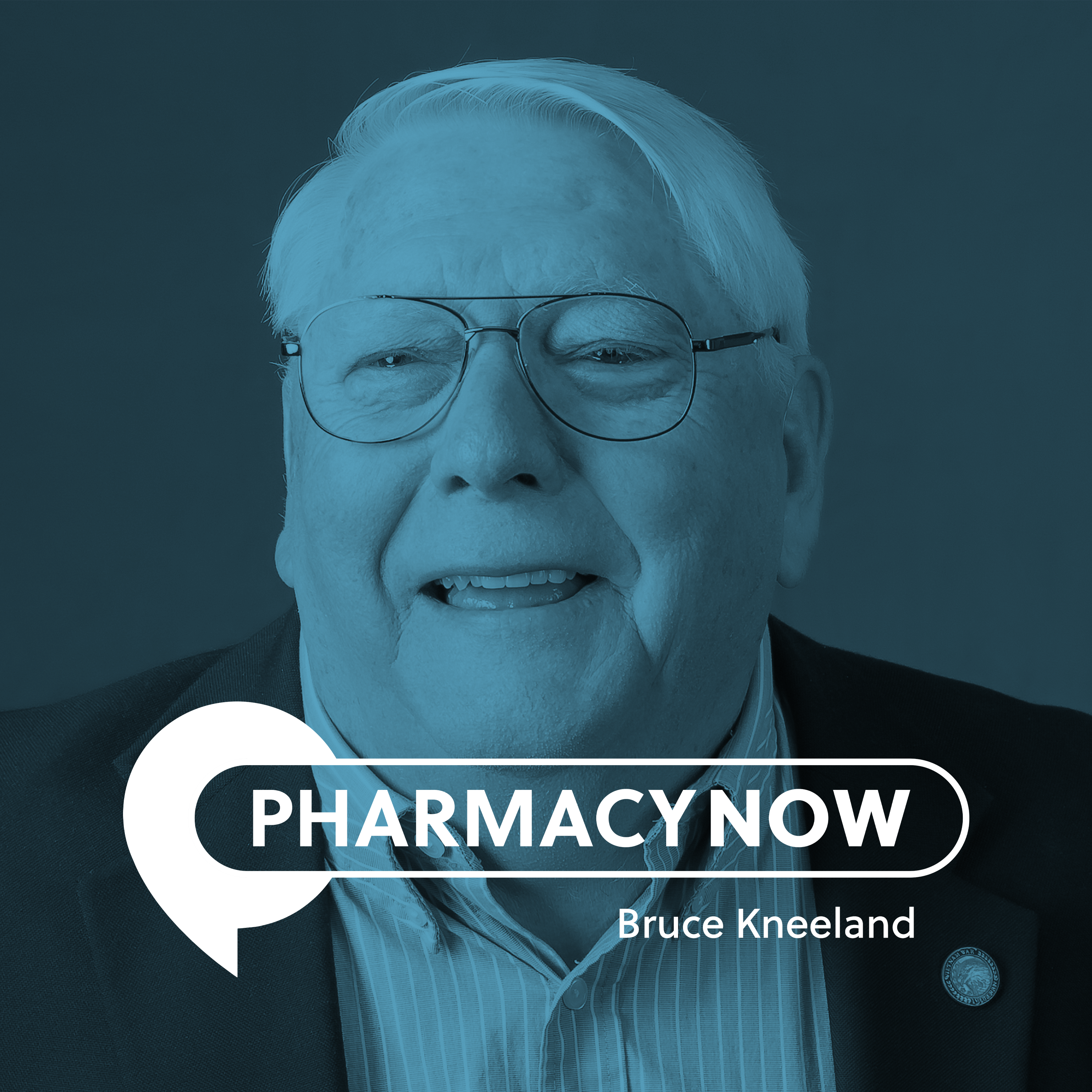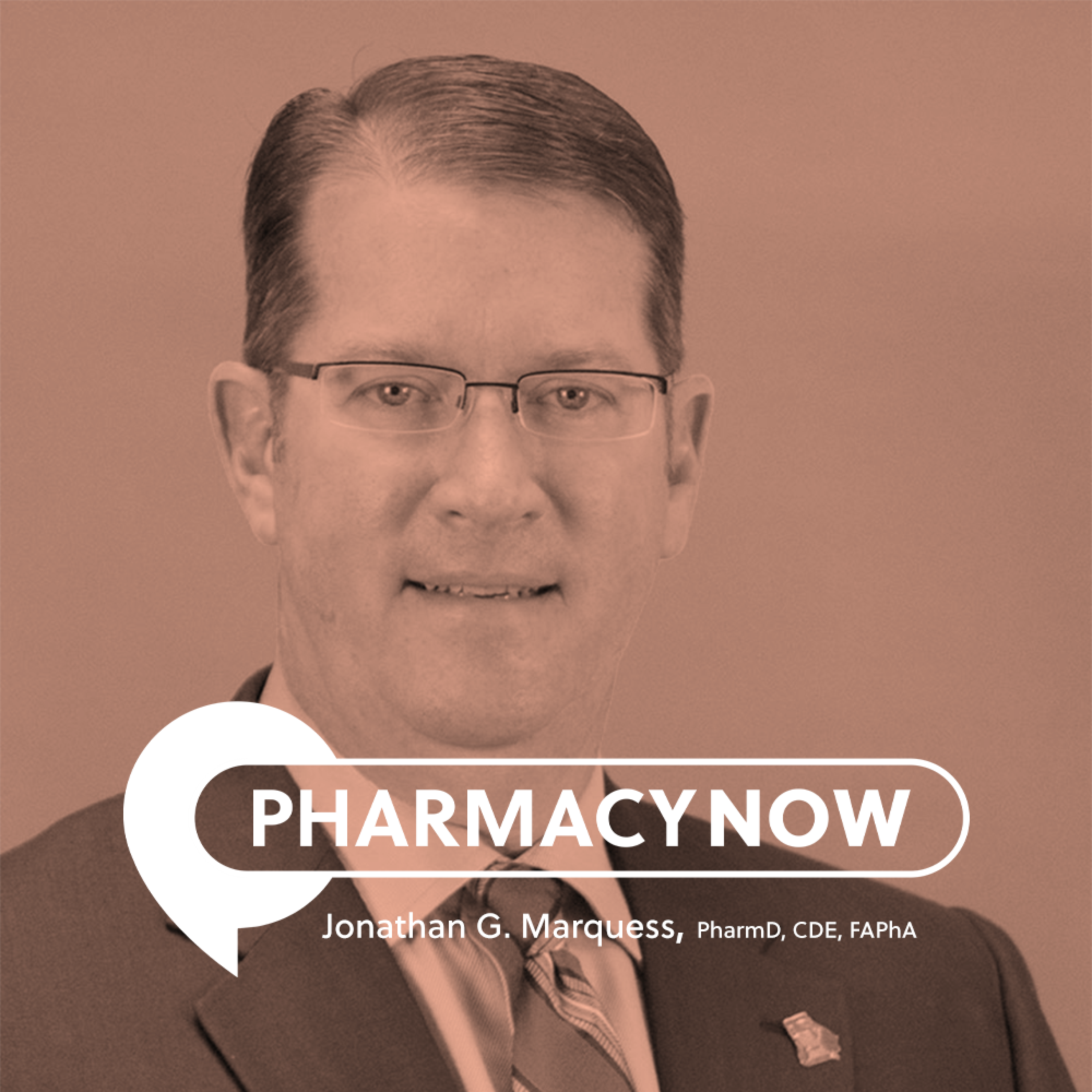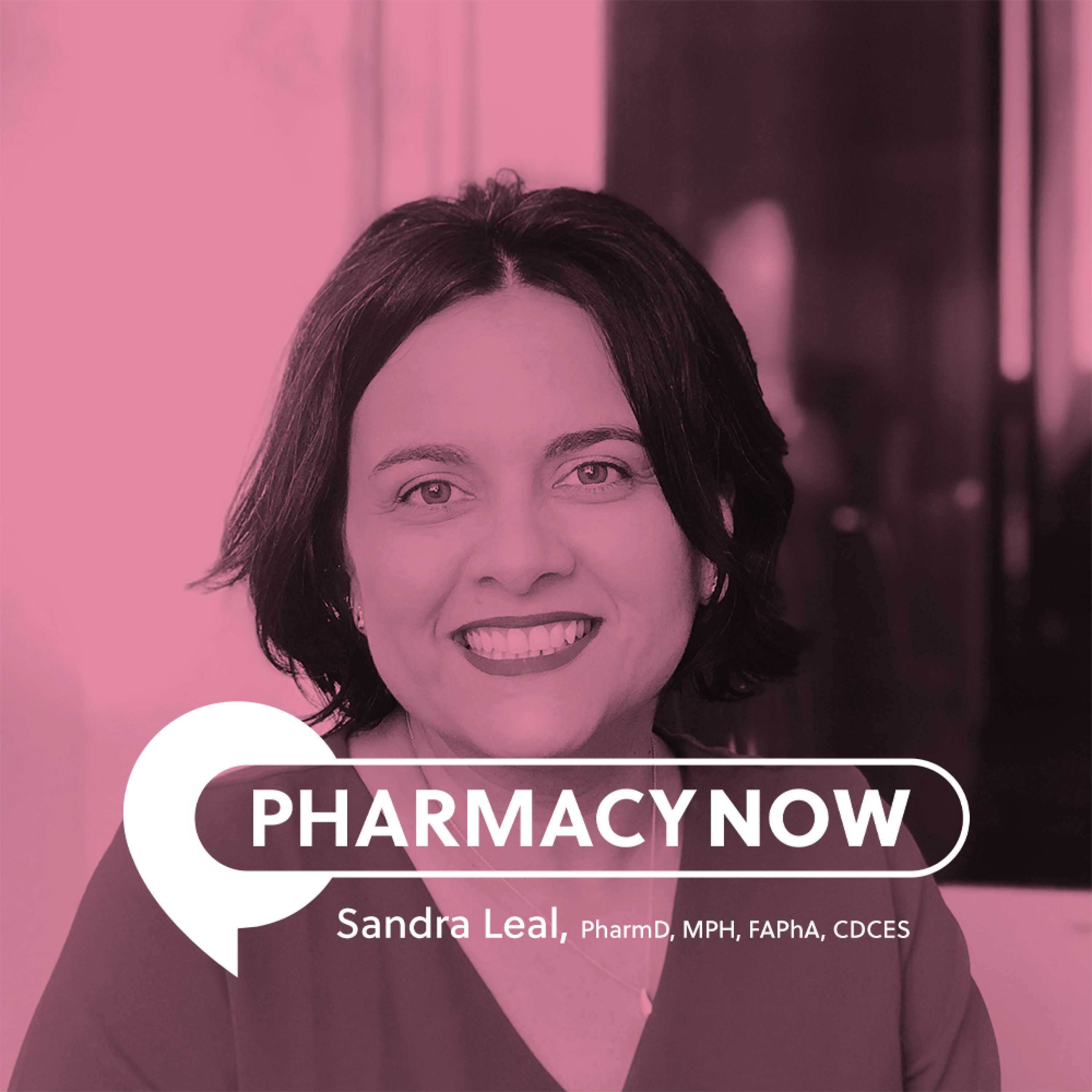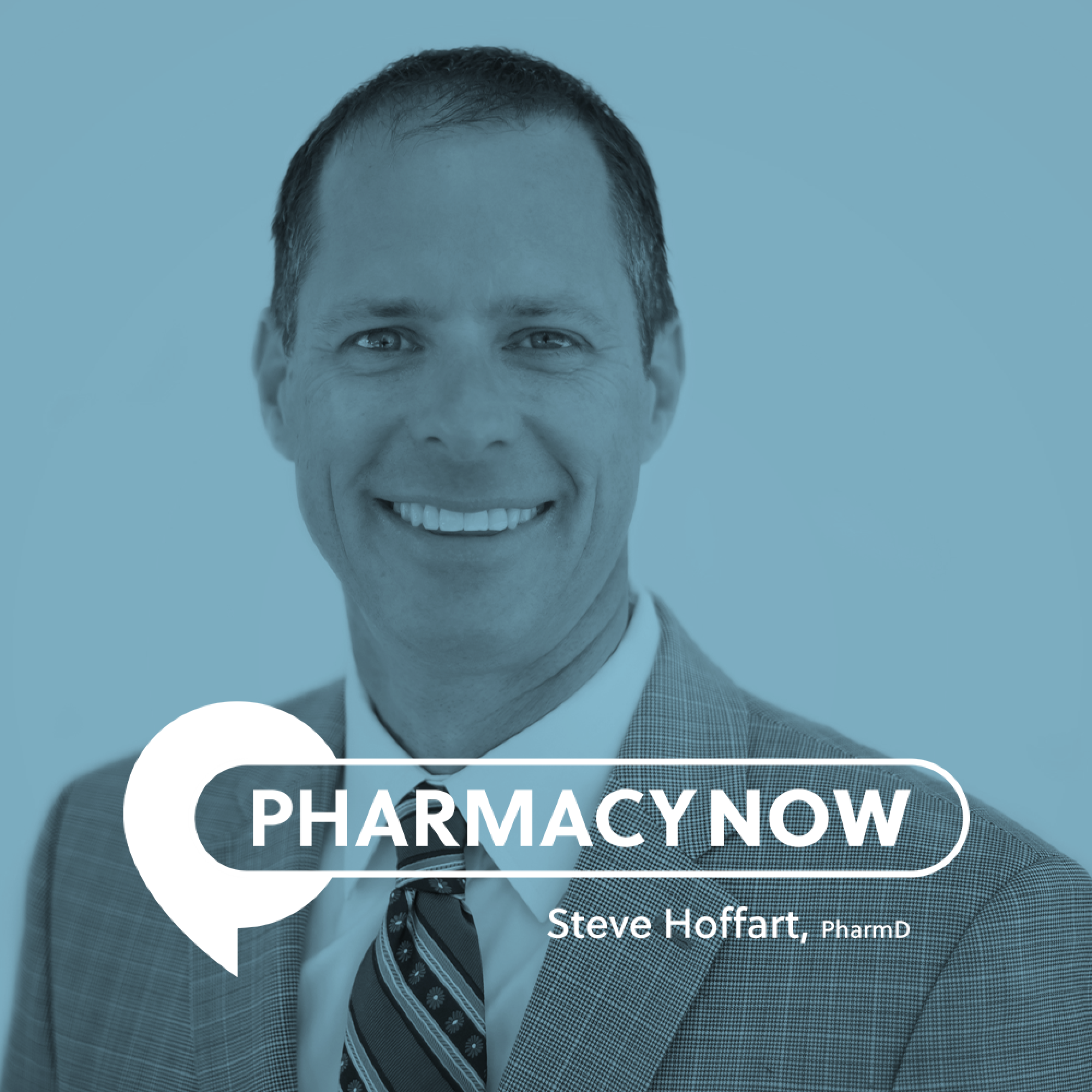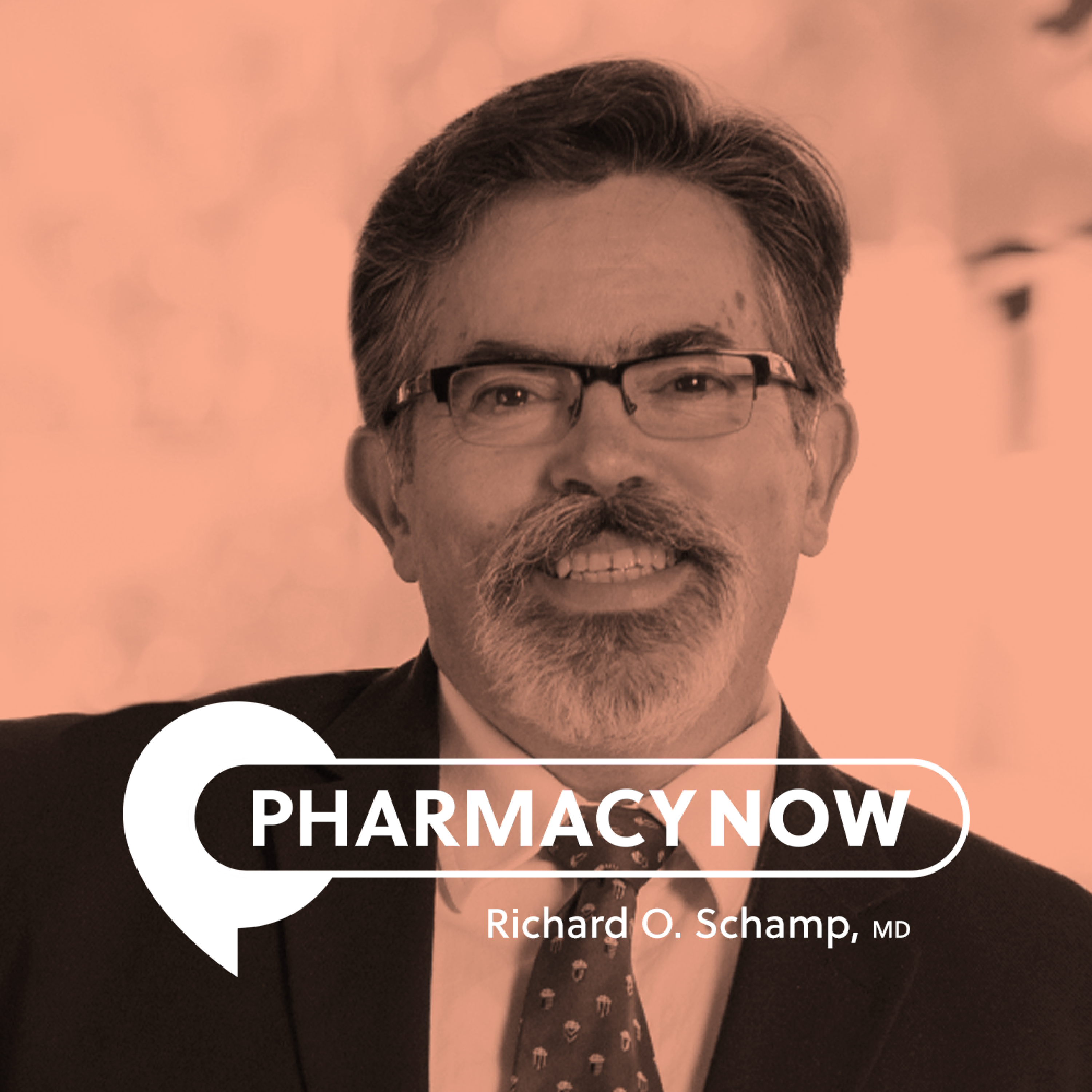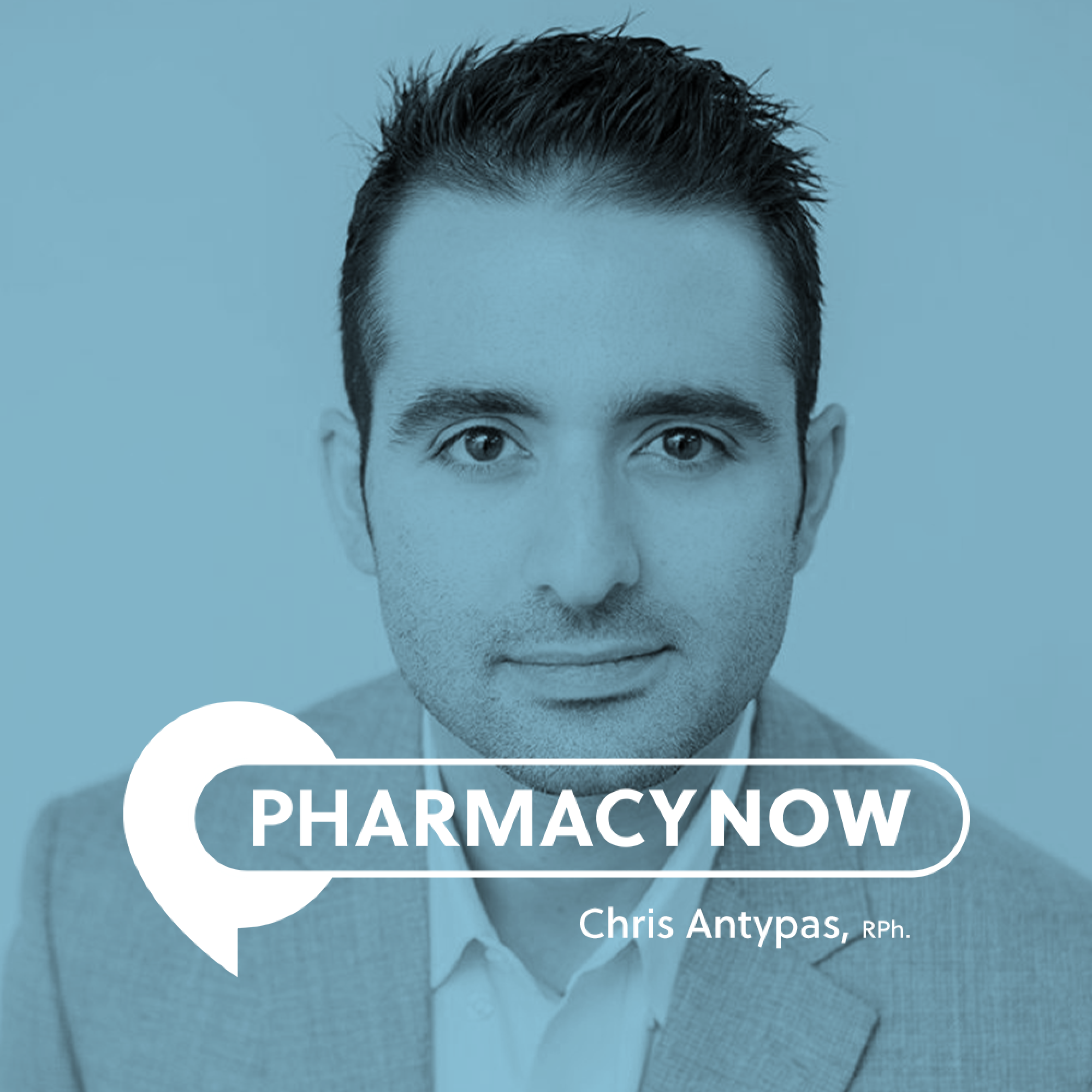Discover PharmacyNow
PharmacyNow

PharmacyNow
Author: PrescribeWellness
Subscribed: 3Played: 12Subscribe
Share
℗ & © 2020 PharmacyNow
Description
Join us as we sit down with the industry's most influential thought leaders to explore how the role of pharmacy continues to evolve. Clinical services, transformative pharmacy practices, workflow enhancements, it's all right here on PharmacyNow.
10 Episodes
Reverse
Our host Scott Vondeylen is joined by Chief Scientific Officer for Tabula Rasa HealthCare (TRHC), Jacques Turgeon, BPharm, PhD to discuss how MedWise® Science is empowering pharmacists to impact patient outcomes—now and in the future. MedWise Science, TRHC’s proprietary technology, is a clinical decision support system that provides pharmacists—and other health professionals—with highly valuable information that helps them make the proper decisions for the pharmacotherapy of their patients. Beyond ensuring patients receive the proper medication for a particular disease state, MedWise Science also helps ensure that the combination of drugs prescribed—the patient’s drug regimen—is optimal. This is critical because when patients have several conditions, they are often required to take multiple medications, which can put a patient’s health at risk by significantly increasing the risk of an Adverse Drug Event (ADE), the 4th leading cause of death in the United States. Preventing and decreasing ADEs is important for multiple reasons. When patients start to experience side effects, they may stop taking the medication, which means patients are no longer receiving the intended benefit of their medication. Further, non-adherence leads to poor outcomes, an increase in doctor and emergency room visits, and an increase in medical expenditure—it’s all linked.Utilizing decision support tools backed by science in conjunction with taking a holistic view of drug regimens can have a major impact on the way pharmacists deliver care to improve medication safety and patient outcomes. To that end, MedWise Science utilizes a one-of-a-kind algorithm to establish the MedWise Risk Level and to cumulatively compare how patients’ medications interact together, all at the same time.Pharmacists can leverage the MedWise Risk Level to determine a patient’s risk for experiencing an ADE, and then be properly alerted to intervene and recommend a Medication Safety Review™ to address concerns and improve medication efficacy. TRHC provides training to ensure that pharmacists can properly use the MedWise decision support tools to conduct Medication Safety Reviews in the pharmacy, as well as offering telephonic support via its national clinical contact centers. The value of MedWise Science has been proven and now there is scientific data to show an association between the level of risk and outcomes. As a patient’s MedWise Risk Level increases, so does their risk of experiencing an ADE, which ultimately leads to an increase in medical expenditure. In fact, TRHC’s Precision Pharmacotherapy Research and Development Institute recently conducted a study in conjunction with DARTNet Institute and found a correlation between risk of premature death and higher medication risk scores, affirming that the appropriate use of medications is critical to avoid harm. The current use and value of the MedWise technology is clear, but that begs the question: What’s next? According to Dr. Turgeon, it appears the future value of MedWise Science could be virtual. Imagine being able to virtually add different medications to a patient’s regimen and then conduct simulations to determine how the MedWise Risk Level may change, altering ADE risk and subsequently impacting outcomes. Well, this is exactly how Dr. Turgeon and his team have already utilized the MedWise technology in two studies—one with elderly patients and another with Medicare patients. By continuing to generate data in large cohorts with multiple disease states, who are managing various drug regimens, can ultimately become a tool for the pharmaceutical industry to test the impact of a new medication coming on the market. Imagine being able to know in advance if and how a medication could change a patient’s MedWise Risk Level. In this scenario, prescribers would have a good idea of potential risk factors, pre-identify populations for ADEs, and be able to limit exposing patients to unwanted side effects. The MedWise Risk Level is now available in the PrescribeWellness Patient Engagement Center at no cost. Interested in learning more? Listen to our latest PharmacyNow Podcast: Precision Pharmacotherapy through MedWise®, or contact us today.
In our 9th episode of the PharmacyNow podcast, our host Scott Vondeylen is joined by Kevin Boesen, PharmD, Chief Sales Officer at Tabula Rasa HealthCare, to discuss how new technology is enhancing medication safety and empowering pharmacists with tools to make a more meaningful impact on patient health – regardless of the setting.More medications = more healthcare costsNumerous studies show that the more medications a patient takes, the more money is spent on the problems they cause. Due to unintended consequences of adverse drug events, the majority of these costs are related to ER visits and hospitalizations, as well as prescribing cascades as a result of the need for additional medications to help alleviate side effects. As a result, medication safety is a $500 billion problem in this country.Current medication safety technology isn’t cutting itToday’s patients are taking more medications than ever before, and the current systems pharmacists use are no longer appropriate for preventing drug interactions. It’s impossible for pharmacists to quickly see how multiple medications are impacting the body on a molecular level. It takes research to understand the potential accumulative effects of multiple medications or look into all the pathways that a patients’ drugs and supplements take. For patients 65 years and over and for those with chronic conditions, this can be a particularly dangerous scenario.MedWiseTM: a new medication safety technologyScott and Kevin discuss MedWise, a new pharmacist software that can assess and predict a patient’s potential medication interactions. This technology provides a matrix that empowers pharmacists with a view that never existed before – it gives a unique look into how patients’ drugs compete and delivers a personalized risk score. Rather than shifting through pages of data, this tool empowers pharmacists to quickly understand a patient’s potential risk. MedWise analyzes the cumulative risk of prescribed medications, as well as over-the-counter drugs and supplements.The future of pharmacyKevin predicts a greater role for pharmacists as primary healthcare providers. Currently, our country has a void for healthcare specialists, and pharmacists will fill that void – helping patients with general assessments and ongoing monitoring, particularly for those with chronic conditions. The pharmacist’s role is already changing and growing, especially as they continue to embrace emerging technologies and the popularity and convenience of telehealth.
In our 7th episode of the PharmacyNow podcast, our host Scott Vondeylen is joined by Tracy Tran PharmD, MBA, Director of Pharmacy Clinical Operations at EPIC Pharmacies, Inc. to discuss how clinical services are shaping the future of pharmacy. Read below for our top 3 takeaways: 1. Get involved in clinical servicesOne of the greatest challenges for pharmacists is achieving proper recognition as healthcare providers in the retail setting. Providing enhanced clinical services presents many opportunities for pharmacists to engage with their patients and to create additional revenue for their pharmacy. To expand the role of the pharmacist, enhanced clinical services, beyond dispensing, must be implemented. Health plans are beginning to recognize the impact that pharmacists can make in the overall health of patients, such as the pharmacist’s role in point-of-care testing. Dr. Tran comments that the industry is seeing health plans begin to reimburse for CLIA waived tests like strep or flu, both of which are extremely attractive to patients. Some states are also allowing collaborative practice agreements to occur between pharmacies and physicians, which enable pharmacies to prescribe antibiotics or antivirals for patients who render a positive result through point-of-care testing.Incorporating clinical services into a pharmacy workflow is critical, yet challenging. According to Dr. Tran, in order to drive results, pharmacists must leverage top performing staff, empower technicians to assume different roles and responsibilities, and champion a med sync or an immunization program. The key to a successful clinical program is total team engagement. With competition from large industry players, it is imperative for community pharmacists to get involved in order to remain competitive. Thankfully, clinical services are just one method for pharmacists to continue to receive due recognition, and reimbursement.2. Document! Document! Document!Unlike physicians, pharmacists may not always be in the habit of documenting encounters. Think about visits to primary care physicians – they are constantly documenting everything that a patient reports, and everything they plan to do in response. Pharmacists must understand the importance of documenting their clinical practices, as proper documentation not only gets them paid for services provided, it may also help to identify additional avenues of care for patients served.Whether you are providing a consultation for adherence, smoking cessation, or hormonal contraceptives, documentation is key. For instance, it was only recently that health plans began recognizing the impact that pharmacists had in the reduction of risks related to opioid overdose. Reimbursement for pharmacists soon followed. It is critical that this pattern of documentation continues, as pharmacists are positioned to impact the health of the patient in many ways, thus additional opportunities for recognition may follow.3. Collaborate with physiciansOne of the most under-utilized opportunities for pharmacists is collaboration with physicians. For example, if a pharmacist has in place a collaborative practice agreement, or standing order with a physician, there are certain criteria that the pharmacist must follow. However, with the agreement in place, pharmacists could perform physician-related activities, in collaboration with the physician, and be able to bill as a medical service, instead of a pharmacy service. A closer collaboration between physicians and pharmacists is key to holistically servicing the needs of the patient.
In our 6th episode of the PharmacyNow podcast, our host Scott Vondeylen sits down with Jonathan Marquess PharmD, owner of multiple community pharmacies throughout the state of Georgia, to discuss the the logistics of hosting a COVID-19 testing clinic within the pharmacy, the criticality of flu shots in 2020, and the future of pharmacy following the pandemic.Read below for our top 3 takeaways: 1. Hosting a COVID-19 testing clinicDr. Marquess knew immediately that he wanted to participate in COVID-19 testing in partnership with the McKesson Corporation, a global leader in healthcare technology and retail pharmacy. Over a span of three weeks, Dr. Marquess’ pharmacies completed over 900 tests at two separate locations. Although there was initial hesitation from his staff, appropriate practices and procedures ensured the safety of both patients and caregivers. Dr. Marquess’ pharmacies even supported self-testing, wherein patients would administer test collection within their own vehicles.Following specimen collection at the pharmacy, all aspects of testing results were managed by a lab corporation, including the delivery of outcomes to patients. Dr. Marquess believes COVID-19 testing is an important opportunity for pharmacists to connect with their community and to be more involved in the health of their patients.2. Don’t miss your (flu) shot!Dr. Marquess believes this is a critical year for flu vaccinations. Most notably, Dr. Marquess shares that he believes it is essential for every patient to be immunized so that healthcare personnel can properly distinguish between Influenza and COVID-19. This year carries great potential for effective vaccinations, which means pharmacies need to be prepared now.In fact, Dr. Marquess has already ordered his pharmacies’ vaccine for this year’s flu season, and is planning to begin immunizing by August. With COVID-19 testing (both PCR and antibody) as well as vaccine administration (flu, and eventually COVID-19), Dr. Marquess believes that there is incredible opportunity for pharmacists to serve their communities by keeping patients both engaged and safe.3. Things to focus on post-pandemicDue to the onset of operational challenges posed during 2020, Dr. Marquess believes that pharmacists need to hit the reset button to begin reevaluating their pharmacy workflow and services. It is important as ever to focus on adherence measures, medication synchronization, and the improvement of the pharmacy’s bottom line. It is time for pharmacists to get creative on how they can best serve their community – to not only survive, but to thrive. Links to learn more about Jonathan Marquess:Jonathan's TwitterJonathan's LinkedInFollow us:twitter.com/PrescribeWellinstagram.com/prescribewellnesslinkedin.com/company/prescribewellnessSubscribe:blog.prescribewellness.com/podcast/Love what you heard? Leave us a review!We want to hear from you!Write in and let us know what you think about the show, who you’d want us to interview on future episodes, and any feedback you have for our team.
The pharmacy landscape is ever evolving, and with challenges presented by the COVID-19 pandemic, those changes seem to happen faster than ever. In this episode of the PharmacyNow Podcast, our host, Scott Vondeylen, sits down to discuss these changes with Sandra Leal, PharmD, MPH, CDE, Executive Vice President for Tabula Rasa HealthCare, and President-elect of the American Pharmacists Association (APhA).Following an in-depth conversation covering legislation for prescribing authority, testing opportunities for pharmacies, and gaps in state and federal regulations, here are our top 3 takeaways: 1. APhA The APhA serves as a top resource for pharmacists on the frontlines of COVID-19. The organization, founded in 1852, represents 60,000 practicing pharmacists, scientists, and interprofessional stakeholders and is a leading advocate for the pharmacy profession. As President-elect, Dr. Leal remains committed to advancing the field of clinical pharmacy, and to continue the recognition of the pharmacist seen during the developing pandemic. The APhA is also a resource for CE and COVID-19 related information to help pharmacies overcome challenges associated with the pandemic. Visit their website at pharmacist.com.2. COVID-19 Testing As the nation’s most accessible care provider, pharmacists are uniquely positioned to help flatten the curve throughout the country. By securing testing opportunities, pharmacies can serve their communities as accessible and trusted healthcare destinations. Dr. Leal also notes that pharmacists are at the ready to serve their communities further through vaccinations – especially once a COVID-19 vaccine becomes available.3. Access for All Dr. Leal has been instrumental in the implementation of the APhA Foundation’s Project IMPACT: Diabetes Prevention, a collaborative program conducted in partnership with the Centers for Disease Control and Prevention (CDC). The program, committed to national diabetes prevention, leverages telehealth capabilities to deliver curriculum to thousands of at-risk adults in underserved communities in the United States.Links to learn more about Sandra Leal:Sandra's TwitterSandra's LinkedInFollow us:twitter.com/PrescribeWellinstagram.com/prescribewellnesslinkedin.com/company/prescribewellnessSubscribe:blog.prescribewellness.com/podcast/Love what you heard? Leave us a review!We want to hear from you!Write in and let us know what you think about the show, who you’d want us to interview on future episodes, and any feedback you have for our team.
In our fourth episode of PharmacyNow, Scott Von Deylen sat down with Rear Admiral (RADM) Pamela Schweitzer, PharmD to discuss the coronavirus and the impact pharmacies can make in their communities. A decorated pharmacist in her field, RADM Schweitzer retired in 2018 from her 4-year term as the Assistant General Surgeon and the 10th Chief Pharmacist Officer of the United States Public Health Service. As Chief Pharmacist Officer (first female in this role), RADM Schweitzer led the coordination of over 1,300 PHS pharmacy officers. Additionally, she has served at the Centers for Medicare and Medicaid Services, Indian Health Service, and Veterans Health Administration. RADM Schweitzer has a wide variety of experiences with developing clinical programs and managing large projects.COVID-19 Brings New Perspectives to the Importance of PharmaciesRADM Schweitzer discussed the impact of the coronavirus on the United States, saying she had been watching it abroad for a while. Once it hit the United States, and began spreading, it was a big wakeup call for a lot of people. It quickly became clear that there needed to be a large availability of COVID-19 tests for communities. Due to her depth of knowledge and experience in the pharmacy world, RADM Schweitzer knew exactly who was in a position to help … pharmacists.Springing into action, she began reaching out to numerous organizations nationwide including Tabula Rasa Healthcare to see who may be interested in helping pharmacies provide testing to their communities. The support and eagerness received helped propel the initiative, and with the passing of the PREP Act in early April, pharmacists were given the ability to administer tests. During this process, a major flaw in the system became apparent. While many people were eager to let pharmacists help provide resources during a crisis, there was still a long way to go to make this a smooth process. Her key takeaway is there is an immense need for “a plan that booms, as soon as we have an emergency, all these other things go into place and there’s not a question. You don’t have to worry about it. We need pharmacies to be in there too and do the same thing.”Prescribing Authority for PharmaciesWhile the need for a quick and effective response to COVID-19 has highlighted the need for pharmacies to be involved in emergency response plans, additional issues have also become apparent. Namely the disconnect in prescribing authority for pharmacies. RADM Schweitzer begins by addressing a good working relationship between pharmacists and physicians. Ideally, there is an open line of communication that allows for continuous, quality care for patients. However it isn’t always that easy. Often times the necessary infrastructure to make that happen isn’t in place. A great example of this, she says, is when she was asked to help transition some Indian Health Service facilities to operate at a more clinical capacity. She found the distribution of the workload at these facilities made it difficult to make this transition. The solution came down to two things: years of work and collaboration with management to increase the automation of certain services to help free up a pharmacist’s time. However, it is important that this position is not cut due to this same automation. Instead, the additional free time provides the pharmacist the ability to spend time at a clinic working with the physicians and medical teams to provide better patient care.RADM Schweitzer says, “I always encourage pharmacists to embrace everything related to public health because they can make such a big difference in improving the health of their communities.”
In this episode of PharmacyNow, Scott Von Deylen sat down with Steve Hoffart, PharmD, RPH, FAAMM, ABAAHP and owner of Magnolia Pharmacy, to discuss how COVID-19 is affecting pharmacy and how the industry is showing up to make a difference during this pandemic. Adapting to Meet Needs Caused by COVID-19One of the biggest challenges facing our communities during the coronavirus pandemic is the shortage of certain supplies, including hand sanitizer. Thanks to Magnolia Pharmacy based in Magnolia, Texas, community heroes on the frontlines now have access to the supplies they so desperately need. Hoffart says, “right now this is what our community needs. This is what our first responders need. So we’re going to step up and do our best.” Utilizing a recipe approved of by the FDA, Magnolia Pharmacy has been able to produce nearly 400 bottles a day. But they had to get creative in the process.Due to the high cost of procuring some of the ingredients needed, Hoffart knew he needed to find something to cut costs. His solution was to reach out to local businesses to sponsor some of the ingredients. Not only did this lower the cost of the product, but it also gave local businesses some much-needed brand awareness during these tough times. And if you’re wondering how much hand sanitizer you should use, Hoffart covers that too. He says what’s most important is liberally covering the front and back of your hands, as well as your fingers. Collaborating with Other Pharmacy OrganizationsAnother challenge pharmacies across the country are facing is the need to change daily operations in light of the coronavirus. One solution is to reach out to pharmacy organizations for best-practices and temporary allowances during the pandemic. These can include things like not requiring a signature for certain purchases to minimize contact, and allowing pharmacists to renew emergency prescriptions. Additionally, Hoffart says it is important to reach out to your network to understand what is working well for other pharmacies. For instance, prior to the influx of COVID-19 cases in Texas, Hoffart spoke to a colleague in Washington about her pharmacy’s change in operations. Her suggestion was to put a plan in place to protect both patients and employees from being exposed to the virus.Protect Your Patients and EmployeesPutting such a large scale change into effect is difficult to say the least, but Hoffart and his staff knew that was just what they had to do. Some of the changes they made included switching all of their operations to drive thru. And if your pharmacy doesn’t have a drive thru, he says a great option is to offer curbside pickup. Additional measures taken by his pharmacy also include screening staff anytime they enter the pharmacy. They are asked a series of common COVID-19 screening questions to see if they or their family are experiencing any symptoms. Additionally, the staff has their temperatures taken when they enter and leave the building.Recognizing that symptoms may not be exhibited for the first few days of the virus, Hoffart says his team has also taken several precautions. Each staff member has their own designated workstation and phone to prevent the spread of any potential germs. Additionally, every hour on the hour they have an alarm to remind them to clean and disinfect their workspace. His last piece of advice for pharmacies is to “create a good work environment where your employees feel like they’re being screened, listened to and that you’re looking out for their best interests.”




